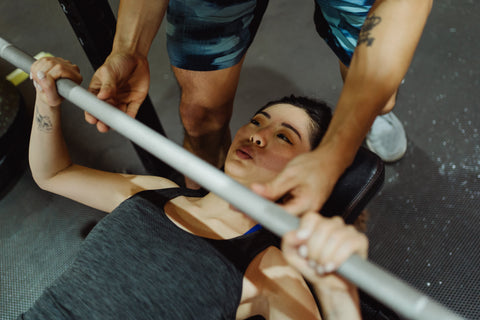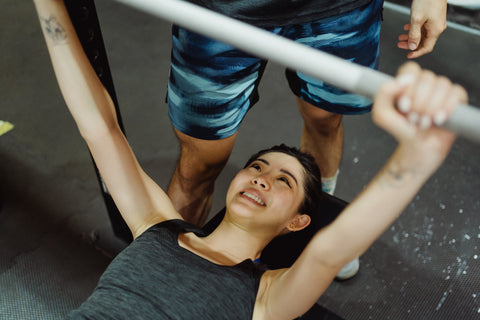The Answer to Chest-Breast Quest
The answer to a more shapely bust is proper exercise. First, let us take a look at the physiological composition of the chest area. In the center of the chest is the heart which is surrounded by the lungs. The lungs are encircled by the rib cage which connects the backbone to the sternum. The major muscles that surround the back portion of the chest are the latissimus dorsi. The primary muscles of the frontal chest are the pectoralis major which lie on both side of the sternum. Up to this point the male and the female physical makeup is relatively the same.
In addition to the above anatomical description, a mature woman develops breasts in order to supply milk to a newborn infant. While the breasts are attached to the pectoralis major muscles, they are not composed of the muscle tissue. Breasts are composed of fatty tissue, glands, and ligaments.
Little can be done to increase the size of the breasts outside of
- Hormone drugs
- Silicone injections
- Surgery
- Or a large decrease or increase in body fat
However, proper exercise can definitely expand the rib cage and increase the size of certain muscle structures. A woman's bustline will take on a new shape amd contour as a result of improved strength and tone in the underlying muscles.
Men cannot only improve the tone of the muscles that make up the chest area but also they can develop muscular size and strength that is greater than a woman's. This is mainly because certain hormones are present in greater quantities throughout a man's body.
The primary functions of your chest muscles are to move your upper arms down and across your body. Each recommended exercise performs one or the other of these functions. The exercises for the chest are described in three groups:
- The first group is done with the equipment found in an athletic club, gym or spa. This is the fastest method of training the chest.
- The second group is performed with barbells and dumbbells.
- The third group is performed with no special equipment.
Group 1 (Using Nautilus Machines)
Pullover Machine: In order to perform this exercise, sit erect in the seat, fasten the seat belt, and push the foot pedal. The foot pedal moves the elbow pads where they are easily accessible to your upper arms. Your arms should move in a rotary fashion until they are slightly behind your waist. The pullover exercise provides up to 240 degree resistance for torso muscles (back, rib cage, chest).
Reference for tutorial on how to use : https://www.youtube.com/watch?v=ZOwR5Ar81rg
Double Chest Machine: Two exercises are involved in this machine. The primary exercise is done in alternate arm fashion. The right arm pushes against the elbow pad as the movement arm rotates to the position. As your right arm returns the left arm is moved in similar fashion. Direct resistance is provided for the large muscles (pectoralis major that lie across the front of your chest without tiring your arm muscles.
Group 2 (Barbell and Dumbbell)
Bench Press: Lying on a bench with support for a barbell, the weight is positioned with a shoulder-width grip and arms locked over your chest. Lower the barbell slowly until it touches your chest, then push it to a straight-armed position. Your chest, arms, and shoulders are exercised in this movement.


Dumbbell pullover: Assume a supine position cross-way on a bench with shoulders in contact with, and head and lower body relaxed and off the bench. A dumbbell or weight plate is held over the chest in a straight-arm position. Take a deep breath, lower the weight behind the head, emphasizing the stretching of the torso, and return to a starting position.
Group 3 (Free-hand Exercise)
Pushup: When assuming the starting position, be certain your arms are straight, palms flat on the floor. All your weight should be supported by your hands and toes. Slowly bend your arms until your nose touches the floor, then push yourself back to the starting position. If you are not strong enough to do a pushup in this manner, perform it on your knees rather than on your toes. You will feel both types in your chest, shoulders, and arms.

Isometric arm cross: Stand with your arms crossed in front of you and parallel to the floor. Slowly begin to cross your arms harder until an intense contraction is felt. Start gradually, using no more than 50% of all-out effort, and gradually build up to a maximum. As isometric contraction should be held about eight seconds with little if any breathing. Breathe deeply before a contraction. Build up the amount of force for the first three seconds and hold it for at least five. You should feel a strong contraction in the pectoralis muscles where they interlace across the sternum. The isometric arm cross should be done only two times during the workout.
Properly performed, the free-hand exercises will give you fair results, the barbell and dumbbell exercises will give you the better results, and the Nautilus machine exercises will give you the best results. However, any attempts at shaping the chest or breasts will be in vain unless the movements are progressive.
A suggested routine would be to start out by performing one set of eight repetitions of the pushup. Work out every other day, or three times a week, and add a repetition every day until twelve are reached (the isometric arm cross should be performed twice each workout). You can now progress to the barbell and the dumbbell movements (Group 2) or the Nautilus machines (Group 1) if they are available. Again, perform eight repetitions on either the Nautilus machine or barbell and progress to twelve repetitions. When twelve repetitions can be performed in a good style, add several pounds and reduce the repetitions to eight.
Yes, proper exercise is the answer to the chest-breast quest. In a short time, you will be able to walk down the street, take a deep breath, roll back those shoulders, and push out that chest. Good luck!
Reference
Darden, E. "The Answer to Chest-Breast Quest". Especially for Women, Leisure Pressure, 1977, 37-41.
